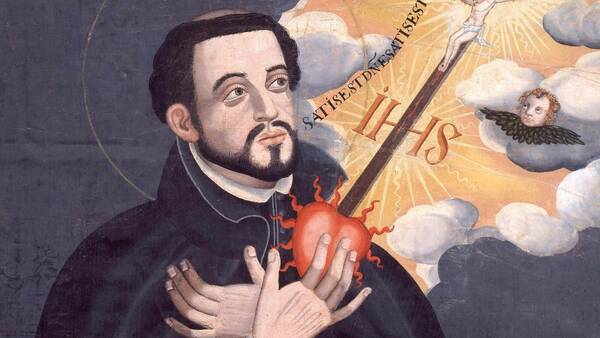October 16th marks the feast of St. Margaret Mary Alacoque (1647–90), a Burgundian nun who experienced a series of visions from 1673 to 1675 that ultimately resulted in her petitioning Church authorities to institute a feast in honor of the Sacred Heart of Jesus on June 8th.
In addition to the feast itself, St. Margaret Mary promoted acts of devotion in honor of the Sacred Heart, chief among which was the reception of Holy Communion on the first Friday of every month, a devotion many still practice to this day. It is for her devotion to the Sacred Heart of Jesus and her untiring efforts to spread that devotion to others that Margaret Mary Alacoque is honored as a saint, and so today’s musical piece will focus not on the saint herself, but on the object of her unwavering devotion: the Sacred Heart of Jesus.
The devotion to the Sacred Heart is twofold: on the one hand, we honor the physical heart of Jesus, the pulsing heart of muscle and blood with its valves and chambers whose very existence encapsulates the mystery of the Incarnation—the heart that testifies that “the Word became flesh” (Jn 1:14); the heart that was pierced by a lance and poured forth the precious lifeblood of Him who loved unto the end. On the other hand, we also honor what the Sacred Heart of Jesus symbolizes: the sheer, unmerited gift of God’s unsurpassable, unfathomable love and mercy, offered without reservation to all who would receive it into their own hearts.
Today's musical piece, the motet Improperium Expectavit by 18th-century Italian composer Giovanni Battista Casali, is a setting of the Offertory text for the feast of the Most Sacred Heart of Jesus, taken from Psalm 69 [68]:21–22b. Translated from the Latin, the text reads:
My heart expected reproach and misery
and I desired one who would grieve with me
and there was none:
I sought one to console me, and I found none:
and they gave me gall as my food,
and in my thirst they gave me vinegar to drink.
The text of today’s piece draws attention to both the physical and the symbolic elements of devotion to the Sacred Heart of Jesus. From the symbolic standpoint, the heart of the one proclaiming the psalm—understood in the context of the feast as the Heart of Jesus himself—is broken; it is inconsolable, overcome with grief at the devastation of reproach and abandonment. And yet there is also an immense physicality in these lines. Hearing this passage from the Psalms in the voice of Jesus, we are reminded perhaps of his words from the Cross: “I thirst” (Jn 19: 28). Here is the one who hungers and thirsts to draw all into the communion of life he shares with the Father and the Spirit, and his longing is met with derision; his thirst for love is slaked with a drink of malice. We see the juxtaposition with stark clarity in the Reproaches for Good Friday: “I gave you saving water from the rock to drink, / and for drink you gave me gall and vinegar.”
To contemplate the Sacred Heart of Jesus is not simply to contemplate the overwhelming love that Jesus pours forth from his Heart; rather, it is to contemplate the mystery that Jesus pours forth his love for us even as we wound his Sacred Heart with our sins. We see this mystery in the way that the Sacred Heart is represented in visual art: pierced, surrounded with the crown of thorns, surmounted by the Cross which ultimately stopped its beating, and yet, even in the midst of these wounds, it is still ablaze, burning with divine love, the love of the God-man who longs for nothing more or less than perfect communion with his people.
We hear this mystery in Casili's motet in the way that musical dissonance (clashing/grating of pitches) gives way to serene consonance (rest/resolution). This is the way that nearly all Western music operates at some level: tension arises in the music that is ultimately resolved. The dissonance somehow serves to help us appreciate all the more the consonance that resolves it. In this sense, consonance seems to purify the dissonance as the notes are brought into harmonious communion with one another in the movement toward resolution. This is what happens when we allow the dissonance of our sinfulness to give way to the love of the Sacred Heart: we ‘sour notes’ are brought into a radiant harmony with Jesus as we learn to sing with ever greater fidelity the hymn of self-giving love he intones from the Cross.
In contemplating with St. Margaret Mary Alacoque the Sacred Heart of Jesus, may we learn to give ourselves over to the ardent love of Christ as it blazes forth from his pierced Heart, that the dissonance within our own hearts may be melted away and dissolve into the consonant, radiant harmony of life in God; that, in the words of St. Paul from the proper reading for today, we may be “rooted and grounded in love, may have the strength to comprehend with all the holy ones what is the breadth and length and height and depth, and to know the love of Christ that surpasses knowledge, so that [we] may be filled with all the fullness of God” (Eph 3:17b–19).


